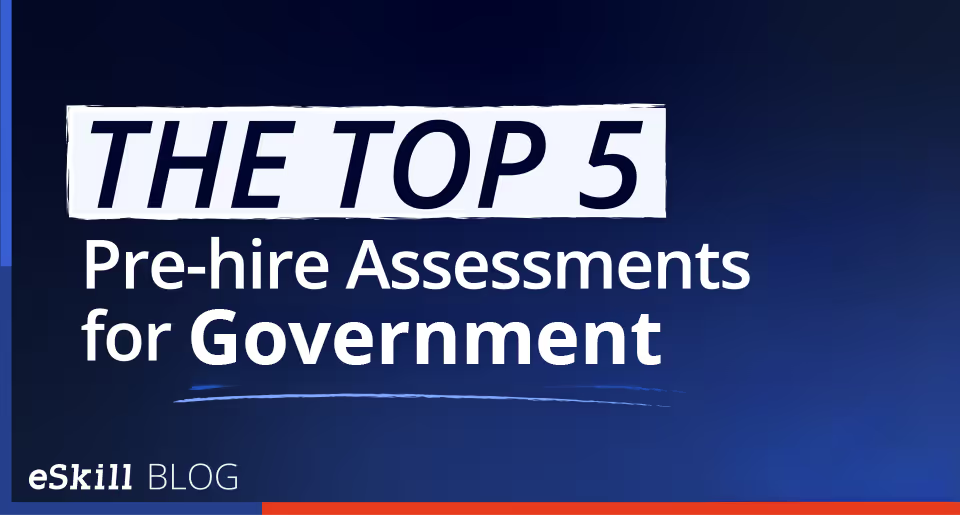Welcome to eSkill’s Test of the Month! In these posts, you’ll find information on popular eSkill assessments from our library of more than 600 subject types. This month, we’re spotlighting our test for commercial drivers.
Our team has their ears to the ground to ensure we’re always on top of changes in hiring practices and vocational requirements. And while we have an expansive library of tests and subjects, we’re always improving existing questions and creating more subject- and role-based tests.
When we heard about the changes to the US freight industry regarding English language requirements due to Executive Order No. 14286, we knew our clients needed a solution — and quick.
In late April 2025, President Trump signed an executive order outlining renewed federal requirements for CDL truck drivers on English comprehension and road sign understanding, called “Enforcing Commonsense Rules of the Road for America’s Truck Drivers.”
The executive order is a reversal of 2016 FMCSA guidance, titled “English Language Proficiency Testing and Enforcement Policy MC-ECE-2016-006,” that softened enforcement of long-existing FMCSA English-language requirements for commercial drivers.
As a result of the executive order, the Board of Directors of the Commercial Vehicle Safety Alliance and the Secretary of the US Department of Transportation, Sean P. Duffy, issued new guidance, with the mandate that failure to speak and read English is made an out-of-service violation, rather than a mere citation — potentially putting current truck drivers out of work. The new guidelines go into effect on June 25, 2025.
The state of Arkansas also passed a law in April that will fine drivers for lack of demonstrated proficiency in English.
With laws being enforced for both federal- and state-level mandates regarding English proficiency for truck drivers, eSkill created the Commercial Driver assessment to give freight industry leaders the tools to ensure compliance among their staff and contractors.
The state of commercial truck driving
The US freight industry has long been contending with a shortage of truck drivers, estimated at 60,000 open positions by the American Trucking Association. That estimate is projected to grow to 160,000 by 2030. However, some believe the shortage is a myth: there is no shortage of willing truck drivers — rather, a high annual turnover rate of 90% (mostly due to poor working conditions and undesirable hours) keeps commercial drivers away from long-haul positions.
Driverless trucks hauling freight across Texas may be one way to solve the shortage, but it’s likely not the easiest way. Regardless of whether the shortage is “real” or not, an aging workforce (the average age of a trucker is 46), and younger workers avoiding the field (the average age of a new trucker is 36), both contribute to an industry needing willing laborers to keep supply chains going.
Even with the federal government launching a pilot apprenticeship program for truck drivers, younger drivers just aren’t interested, and high turnover persists.
Foreign-born populations began entering the trucking industry in larger numbers in the last three decades, now making up around 18% of all US commercial truck drivers. There is a higher proportion of immigrants within the trucking industry than within the US as a whole — compare 19% to the roughly 15% of immigrants making up the US population.
However, the Department of Transportation’s Federal Motor Carrier Safety Administration (FMCSA) has long required that commercial drivers understand English, can interpret road signs, and are able to safely operate these commercial vehicles.
While many were previously granted leniency under guidance established in 2016 , with the executive order from late April requiring the FMCSA uphold “commonsense rules of the road for American truck drivers,” trucking companies are now faced with conforming to soon-to-be established requirements for the drivers they hire.
With companies employing foreign-born truckers and facing revived standards for their drivers, how do they ensure their drivers — the ones they hire and the ones they currently employ — are in line with the signed executive order by the date of enforcement, June 25?
New (but old) federal truck driver requirements
The executive order determines that proficiency in English is a non-negotiable safety requirement for professional drivers. The FMCSA has long required that commercial drivers must be able to:
- Read and understand traffic signs
- Communicate with traffic safety, border patrol, agricultural checkpoints, and cargo weight-limit station officers
- Respond to official inquiries
- Make entries on reports and records
What does the Commercial Driver assessment cover?
The Commercial Driver assessment is meant to cover topics outlined in the April 2025 executive order on common sense guidelines for commercial truck drivers, generally to comply with existing FMCSA regulations established in the 1930s. They are meant to simulate real-world English vocabulary, industry jargon, and phrases truck drivers may encounter on-the-job.
These topics and formats include:
- Verbal Language Requirements: Audio and written questions where test takers must listen to or read English phrases related to common on-the-job situations and choose the most appropriate response. These scenarios may involve conversations with dispatchers, delivery instructions, roadside assistance, or customer interactions.
- Written Language Requirements: Reading comprehension questions that assess a test taker’s ability to understand written instructions, safety protocols, and official forms.
- Road sign interpretation: Reading and identifying standard U.S. road signs and their official meanings. This includes interpreting regulatory signs, warning signs, and informational markers to ensure safe and lawful vehicle operation.
Assessment type
The Commercial Driver test is a multiple-choice test that employs audio questions, graphics, and more to assess a candidate’s ability to understand spoken English, respond appropriately, and interpret US road signage.
Ideal Industries & Jobs
The Commercial Driver assessment is ideal for truck drivers in all industries within the US, from long-haul truckers to local delivery drivers, ensuring they can understand safety signage, communicate clearly at checkpoints, and complete essential documentation accurately.
Trucking & Freight Transportation
Long-haul and regional carriers, last-mile delivery services, and owner-operator fleets
Logistics & Supply Chain
Distribution centers & warehousing operations with delivery components
Construction
Companies employing CDL holders to transport heavy equipment or materials
Oil & Gas, Mining
Drivers moving hazardous materials or heavy loads to and from remote sites
Waste Management
Drivers of sanitation trucks or hazardous waste transporters
Public Transit & Municipal Services
Bus drivers, utility fleet drivers, snowplow operators
Retail & Wholesale Distribution
Big box retailers and wholesalers with private fleets
Complementary Questions
With eSkill pre-hire assessments, you can create custom tests that mix and match assessment categories to better measure a candidate. Instead of simply testing English knowledge, you can test for complimentary skills required for the job. Consider pairing the Commercial Driver assessment with additional question types:
Directions and Maps
Reading Charts and Tables
Attention to Detail
Hazardous Materials Handling
Why use the Commercial Driver assessment?
When a driver is placed out-of-service (OOS) due to communication issues, it affects both your operations and your bottom line. If a driver has to wait roadside for someone else to retrieve the load, that’s valuable time and money lost.
Currently, 18% of U.S. truck drivers are foreign-born — meaning a significant portion of the workforce may speak English as a second language. To ensure safety and compliance, it’s essential to verify that drivers can understand and respond to official instructions.
The Commercial Driver test helps you assess the English proficiency of both current and prospective employees. Whether you're hiring or evaluating existing staff, this test ensures your team is prepared to meet industry and legal standards.
At eSkill, we’re committed to keeping pace with evolving hiring practices and vocational regulations, so you can stay compliant and keep freight moving.

Get ademo.



.avif)


